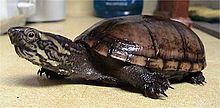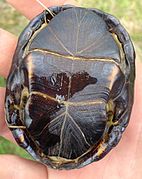Eastern mud turtle
| Eastern mud turtle | |
|---|---|

| |
| Scientific classification | |
| Domain: | Eukaryota |
| Kingdom: | Animalia |
| Phylum: | Chordata |
| Class: | Reptilia |
| Order: | Testudines |
| Suborder: | Cryptodira |
| Family: | Kinosternidae |
| Genus: | Kinosternon |
| Species: | K. subrubrum
|
| Binomial name | |
| Kinosternon subrubrum Bonnaterre, 1789[2]
| |
| Synonyms[3] | |
|
List
| |
The eastern mud turtle (Kinosternon subrubrum) or common mud turtle[2] is a common species of turtle in the family Kinosternidae. The species is endemic to the United States. There are two recognized subspecies.
Description
[edit]The eastern mud turtle is a small and often hard to identify species. It measures 3–4 in (7.6–10.2 cm) in carapace length. The carapace is keelless, lacks any pattern, and varies in color from yellowish to black. The plastron is large and double hinged, and can be yellowish to brown, and may sometimes have a dark pattern. The chin and throat are a yellowish grey, streaked and mottled with brown, while the limbs and tail are grayish. The eye, or iris, of the eastern mud turtle is yellow with dark clouding, and its feet are webbed.
-
In Mississippi
-
Carapace, Mississippi
-
K. s. subrubrum plastron, in Maryland
-
K. s. subrubrum plastron, in Delaware
-
Plastron, in Florida
-
Plastron, in Mississippi
Etymology
[edit]The specific name, subrubrum, meaning "under red", refers to the red-orange plastron of hatchlings.[4]
Diet
[edit]The eastern mud turtle is omnivorous and feeds on insects, crustaceans, mollusks, amphibians, carrion, and aquatic vegetation. Smaller eastern mud turtles prey on small aquatic insects, algae, and carrion, whereas larger ones can feed on any type of food.[5]
Movement
[edit]Eastern mud turtles have been documented to migrate seasonally from uplands that they frequent to wetlands and aquatic movement in their home ranges.[6] Their home ranges can be as small as .05 ha to 69.5 ha, depending on how close together their essential resources are. [7] In anthropogenically altered landscapes, such as golf courses, Eastern Mud Turtles were shown to cross an average of four different habitat types while emerging during the summer and fall.[8]
Habitat
[edit]Mud turtles (genus Kinosternon) are fresh water turtles that are found in the Southeastern and Northeastern United States.[9] They live in rivers, lakes and swamps. Mud turtles prefer ponds that have a lot of vegetation. These animals can generally be found in spring-fed streams, and they prefer clean, oxygenated water. The Eastern mud turtle rarely basks, but in the instance they do, they will bask on rocks or debris floating on the surface of the water.[10] In the wild, they also prefer sandy and muddy areas, as they will hibernate by burrowing into the mud. The Eastern Mud Turtle prefers hibernacula sites about 70 meters from wetlands and that have a large amount of leaf and pine litter and not too much tree cover. They will burrow at the wetland edges at a minimum depth of 1.3 cm below the soil surface to a maximum depth of 3 cm.[10] The leaf litter helps to keep the soil moisture and the temperature consistent, while a more open canopy exposes turtles to higher temperatures before emergence.[11]
Mud turtles can tolerate brackish water so they may be found near salt marshes and on coastal islands.[9]
Reproduction
[edit]
Mating occurs in K. subrubrum during early spring followed by egg laying in May to early June.[12] Clutch sizes vary from 2 to 5. Clutch size increases as female plastron length increases and they have at least 3 clutches/year.[13]
Reproduction in this species varies greatly depending on latitudinal location. Clutches per year for this species have been reported to be one clutch per year in some states and multiple clutches in others.[14] In a study conducted in South Carolina, clutch frequency in warmer areas averaged multiple clutches, but two clutches per year were the approximate average in cooler regions of the state.[12] The incubation period of the eggs can range from 76 to 124 days. K. subrubrum hatchlings have a wider carapace than the width of the eggs they hatch from, indicating that the carapace unfolds immediately upon hatching.[14]
Geographic range
[edit]The eastern mud turtle is found in the US states of Alabama, Arkansas, Delaware, Florida, Georgia, Illinois, Indiana, Kentucky, Louisiana, Maryland, Mississippi, Missouri, New Jersey, New York, North Carolina, Oklahoma, Pennsylvania, South Carolina, Tennessee, Texas, and Virginia.[2]
In Indiana, the eastern mud turtle is listed as an endangered species.[15]
Diseases
[edit]In 2014 on the Savannah River Site in Aiken, South Carolina the first case of ranavirus in an eastern mud turtle was detected. This virus affects amphibians, fish, and reptiles and causes oral plaque, ulceration, and conjunctivitis in infected species eventually resulting in death.[16]
Subspecies
[edit]Two subspecies are recognized as being valid, including the nominotypical subspecies.[2][17]
- K. s. subrubrum (Bonnaterre, 1789) – eastern mud turtle (nominate subspecies)
- K. s. hippocrepis Gray, 1855 – Mississippi mud turtle
The former subspecies K. s. steindachneri (Siebenrock, 1906)--Florida mud turtle was elevated to species status in 2013.[18]1
Nota bene: A trinomial authority in parentheses indicates that the subspecies was originally described in a genus other than Kinosternon.
-
K. s. subrubrum, Delaware
-
K. s. subrubrum, New Jersey
-
K. s. hippocrepis, Missouri
-
K. s. hippocrepis, Missouri
-
K. s. hippocrepis
-
K. s. hippocrepis, Arkansas
-
K. s. hippocrepis, Arkansas
-
K. s. hippocrepis, Arkansas
-
K. s. hippocrepis, Arkansas
References
[edit]- ^ Van Dijk, P.P. (2011). "Kinosternon subrubrum". The IUCN Red List of Threatened Species. doi:10.2305/IUCN.UK.2011-1.RLTS.T163435A5606303.en.
- ^ a b c d Rhodin, Anders G.J.; van Dijk, Peter Paul; Iverson, John B.; Shaffer, H. Bradley (2010-12-14). "Turtles of the world, 2010 update: Annotated checklist of taxonomy, synonymy, distribution and conservation status" (PDF). Chelonian Research Monographs. 5: 000.98. doi:10.3854/crm.5.000.checklist.v3.2010. ISBN 978-0965354097. Archived from the original (PDF) on 2011-07-17.
- ^ Fritz, Uwe; Havaš, Peter (2007). "Checklist of Chelonians of the World". Vertebrate Zoology. 57 (2): 259–260. doi:10.3897/vz.57.e30895. ISSN 1864-5755.
- ^ Iverson, John B. "Kinosternon subrubrum." (1977).
- ^ "Virginia Herpetological Society". www.virginiaherpetologicalsociety.com. Retrieved 2022-04-28.
- ^ Cordero, Gerardo Antonio (June 2012). "Long Distance Aquatic Movement and Home-Range Size of an Eastern Mud Turtle, Kinosternon subrubrum, Population in the Mid-Atlantic Region of the United States". Chelonian Conservation and Biology. 11 (1): 121–124. doi:10.2744/CCB-0874.1. S2CID 86229741.
- ^ Cordero, G. A., Reeves, R., & Swarth, C. W. (2012). Long Distance Aquatic Movement and Home-Range Size of an Eastern Mud Turtle, Kinosternon subrubrum, Population in the Mid-Atlantic Region of the United States. Chelonian Conservation and Biology, 11(1), 121–124. https://doi.org/10.2744/CCB-0874.1
- ^ Harden, Leigh Anne; Price, Steven J.; Dorcas, Michael E. (2009). "Terrestrial Activity and Habitat Selection of Eastern Mud Turtles (Kinosternon subrubrum) in a Fragmented Landscape: Implications for Habitat Management of Golf Courses and Other Suburban Environments". Copeia. 2009 (1): 78–84. doi:10.1643/CH-08-037. ISSN 0045-8511. JSTOR 25512198. S2CID 86634007.
- ^ a b Harden, Leighanne; Price, Stevenj.; Dorcas, Michaele. (2009). "Terrestrial Activity and Habitat Selection of Eastern Mud Turtles (Kinosternon subrubrum) in a Fragmented Landscape: Implications for Habitat Management of Golf Courses and Other Suburban Environments". Copeia. 2009: 78–84. doi:10.1643/ch-08-037. S2CID 86634007.
- ^ a b Plowman, Bianca. "Kinosternon subrubrum (Eastern Mud Turtle, Common Mud Turtle)". Animal Diversity Web. Retrieved 2022-04-29.
- ^ Steen, David A.; Sterrett, Sean C.; Miller, Shannan A.; Smith, Lora L. (September 2007). "Terrestrial Movements and Microhabitat Selection of Overwintering Subadult Eastern Mud Turtles (Kinosternon Subrubrum) in Southwest Georgia". Journal of Herpetology. 41 (3): 532–535. doi:10.1670/0022-1511(2007)41[532:TMAMSO]2.0.CO;2. ISSN 0022-1511. S2CID 86453610.
- ^ a b Gibbons, J. Whitfield (September 1983). "Reproductive Characteristics and Ecology of the Mud Turtle, Kinosternon subrubrum (Lacepede)". Herpetologica. 39 (3): 254–271. JSTOR 3892569.
- ^ Iverson, John B. (1979). "Reproduction and Growth of the Mud Turtle, Kinosteron subrubrum (Reptilia, Testudines, Kinosternidae), in Arkansas". Journal of Herpetology. 13 (1): 105–111. doi:10.2307/1563764. JSTOR 1563764.
- ^ a b Houseal, Timothy W.; Carr, John L. (1983). "Notes on the Reproduction of Kinosternon subrubrum (Testudines: Kinosternidae) in East Texas". The Southwestern Naturalist. 28 (2): 237–239. doi:10.2307/3671393. ISSN 0038-4909. JSTOR 3671393.
- ^ Indiana Legislative Services Agency (2011), "312 IAC 9-5-4: Endangered species of reptiles and amphibians", Indiana Administrative Code, retrieved 28 Apr 2012
- ^ Winzeler, ME; Hamilton, MT; Tuberville, TD; Lance, SL (2015). "First case of ranavirus and associated morbidity and mortality in an eastern mud turtle Kinosternon subrubrum in South Carolina". Diseases of Aquatic Organisms. 114 (1): 77–81. doi:10.3354/dao02849. PMID 25958808.
- ^ "Kinosternon subrubrum ". The Reptile Database. www.reptile-database.org.
- ^ Rhodin, Anders G.J.; Iverson, John B.; Bour, Roger; Fritz, Uwe; Georges, Arthur; Shaffer, H. Bradley; van Dijk, Peter Paul (August 3, 2017). "Turtles of the World: Annotated Checklist and Atlas of Taxonomy, Synonymy, Distribution, and Conservation Status (8th Ed.)" (PDF). Chelonian Research Monographs. 7: 15, 44, 222. ISBN 978-1-5323-5026-9. Retrieved October 4, 2019.
Further reading
[edit]- Behler JL, King FW (1979). The Audubon Society Field Guide to North American Reptiles and Amphibians. New York: Knopf. 742 pp. ISBN 0-394-50824-6. (Kinosternon subrubrum, pp. 441–442 + Plates 318, 320, 321).
- Bonnaterre PJ (1789). Tableau encyclopédique et méthodique des trois règnes de la nature, Erpétologie. Paris: Panckoucke. xxviii + 71 pp. + 66 plates. (Testudo subrubra, new species, pp. 27–28 + [turtles] Plate 5, figure 1). (in French and Latin).
- Boulenger GA (1889). Catalogue of the Chelonians, Rhynchocephalians, and Crodcodiles in the British Museum (Natural History). New Edition. London: Trustees of the British Museum (Natural History). (Taylor and Francis, printers). x + 311 pp. + Plates I–VI. (Cinosternon pensylvanicum, pp. 39–40).
- Conant R (1975). A Field Guide to Reptiles and Amphibians of Eastern and Central North America, Second Edition. Boston: Houghton Mifflin. xviii + 429 pp. + Plates 1–48. ISBN 0-395-19979-4 (hardcover), ISBN 0-395-19977-8 (paperback). (Kinosternon subrubrum subrubrum, p. 43 + Plates 4, 5 + Map 13).
- Goin CJ, Goin OB, Zug GR (1978). Introduction to Herpetology, Third Edition. San Francisco: W.H. Freeman. xi + 378 pp. ISBN 0-7167-0020-4. (Kinosternon s. subrubrum, detailed description of nesting, p. 264).
- Powell R, Conant R, Collins JT (2016). Peterson Field Guide to Reptiles and Amphibians of Eastern and Central North America, Fourth Edition. Boston and New York: Houghton Mifflin Harcourt. xiv + 494 pp., 47 color plates 207 figures. ISBN 978-0-544-12997-9. (Kinosternon subrubrum, pp. 225–227, Figure 102 + Plates 19, 21).
- Smith HM, Brodie ED Jr (1982). Reptiles of North America: A Guide to Field Identification. New York: Golden Press. 240 pp. ISBN 0-307-13666-3. (Kinosternon subrubrum, pp. 26–27).
- Stejneger L, Barbour T (1917). A Check List of North American Amphibians and Reptiles. Cambridge, Massachusetts: Harvard University Press. 125 pp. (Kinosternon subrubrum subrubrum, p. 112).
- Zim HS, Smith HM (1956). Reptiles and Amphibians: A Guide to Familiar American Species: A Golden Nature Guide. New York: Simon and Schuster. 160 pp. (Kinosternon subrubrum subrubrum, pp. 19, 23, 155).
External links
[edit]- Eastern mud turtle - Kinosternon subrubrum Species account from the Towson University Reptiles of Maryland Web Page.

















